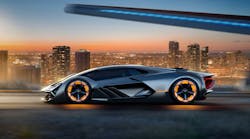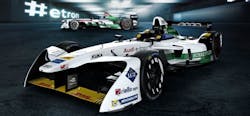Lamborghini is the latest company joining the parade to electric sports cars, with aid from two laboratories of the Massachusetts Institute of Technology. It marks the first steps of a possible future Lamborghini electric super sports car (Fig. 1).
Audi recently introduced its e-tron FE04 electric motorsports car concept with help from its technology partner Schaeffler (Fig. 2). Schaeffler, headquartered in Herzogenaurach, Germany, produces components and systems for vehicles with drive trains based on internal combustion engines as well as hybrid and electric vehicles.
Lamborghini’s new design concept is called the Terzo Millennio. The concept physically imagines design and technology theories of tomorrow, all the while sustaining the visual intrigue and performance associated with the automaker. It is made for future super sports car enthusiasts.
The technological goal of the project is to enable Lamborghini to address the future of the super sports car in five different dimensions: energy storage systems, innovative materials, propulsion system, visionary design, and emotion.
The first two dimensions are conceived together with the two MIT laboratories: the Dinca Research Lab, led by Professor Mircea Dinca of Department of Chemistry, and the Mechanosynthesis Group, led by Professor Anastasios John Hart of the Department of Mechanical Engineering. The collaboration is substantially financed by Automobili Lamborghini and intended to lead to radical innovation in energy storage systems technology and material science.
Energy Storage Systems
The strategy of creating super sports cars with uncompromising performance generates Lamborghini’s motivation to revolutionize the approach to energy storage, moving away from conventional batteries and investigating the potential of supercapacitors to equip the Terzo Millennio.
This is in line with the application of low voltage supercapacitors in the V12 Aventador, which started five years ago. The next logical step is the development of a storage system able to deliver high peak power and regenerate kinetic energy with very limited influence from aging and cycling during the vehicle’s life, along with the ability to symmetrically release and harvest electric power. Thus, the collaboration with Dinca is aiming to overcome the limits of today’s technology and close the gap on conventional batteries’ energy density while preserving the high power, symmetrical behavior, and very long lifecycle related to supercapacitor technology.
“The new Lamborghini collaboration allows us to be ambitious and think outside the box in designing new materials that answer energy storage challenges for the demands of an electric sport vehicle,” said Dinca. “We look forward to teaming up with their engineers and work on this exciting project.”
Innovative Materials
To support this revolution in energy storage systems, materials and their functions have to change, too. Lamborghini aims to further develop its leadership in the design and production of carbon fiber structures and parts, enhancing its ability to develop features and functions that take lightweight materials to the next level.
For this reason, the cooperation with Hart will investigate the new manufacturing routes for carbon fiber materials constituting the bodyshell of the Terzo Millennio, which will also act as an accumulator for energy storage and enable the complete body of the car to be used as a storage system. “We are thrilled to combine our expertise in advanced materials and manufacturing with the vision and support of Automobili Lamborghini, and to realize new concepts that will shape the future of transportation,” Hart said.
The project also aims to combine the technology to continuously monitor the whole carbon fiber structure, both visible and invisible, with the concept of “self-healing”: the target is to provide the Terzo Millennio with the ability to conduct its own health monitoring to detect cracks and damages in its substructure derived from accidents.
In this case, a self-repairing process starts via micro-channels filled with healing chemistries, reducing to zero the risks of small cracks propagating further in the carbon fiber structure. This allows further weight reduction with increased use of carbon fiber or the application of CFK to high-fatigue parts.
Propulsion System
The energy storage system goes hand-in hand with performance. Each wheel incorporates an integrated electric engine, perpetuating the commitment to four-wheel drive, and in the meantime harvesting the opportunities provided by electric motors: high torque, reversibility, and the possibility of moving energy by wire. The Terzo Millennio therefore also embodies the first steps for Lamborghini to go in the direction of creating a “Lamborghini Electric.” Moving the electric motors into the wheels has another positive effect: freedom for designers and aerodynamicists.
The Terzo Millenio is the visionary outcome conceived by the Lamborghini Centro Stile to express future design elements, taking into account the radical changes in technology and anticipating elements of forthcoming Lamborghini design. An example for a very strong statement is the evolution and further development of the Lamborghini typical Y-signature in the front and rear lights.
As a result of the change in technologies the design can be a radical expression of aerodynamic supremacy, based around an entirely new architecture, totally dedicated to perfecting airflow. A highly advanced monocoque based on Lamborghini’s Forged Composite technology can be modelled, containing only the energy accumulation system and driver’s and co-driver’s seats, inspired by race cars.
Fundamental to a Lamborghini hypercar of the future is sustaining the emotion of driving a Lamborghini, and an immersive driver experience. The responsiveness of the electric motors, the four-wheel torque control and the dynamic body control system will enhance the driver’s experience. Finally, the consequent aerodynamics and innovative lightweight approach will result in a new dimension of longitudinal as well as lateral dynamics—in this combination, and until today, unknown from electrified cars.
The Terzo Millenio’s virtual cockpit allows more than travelling the highways of a future world: its Piloted Driving simulation allows the driver to be taken around a track such as Imola by a virtual expert before the driver takes over to feel like a “pilot” himself, experiencing the real car and circuit while following the virtual ghost car.



